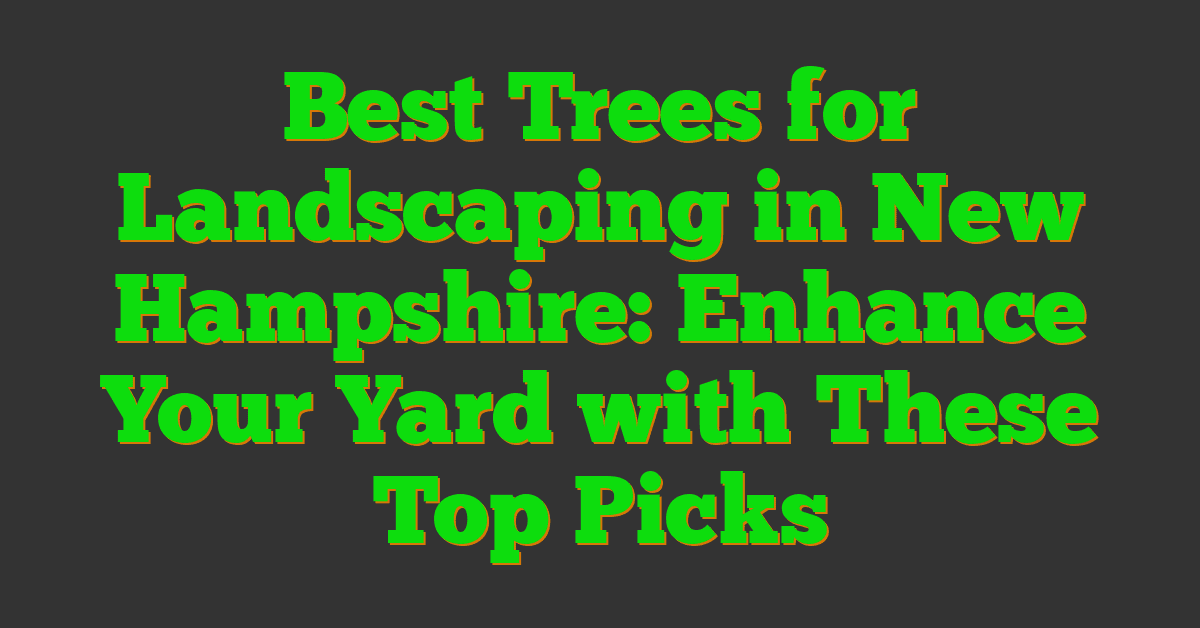If you’re looking to add some trees to your New Hampshire landscape, there are plenty of options to choose from. However, not all trees are created equal, and it’s important to choose the right ones for your specific needs and preferences. In this article, we’ll explore some of the best trees for landscaping in New Hampshire and provide some tips for choosing the right ones for your property.

Understanding New Hampshire’s climate is an important first step in selecting trees for your landscape. New Hampshire experiences a humid continental climate, characterized by cold winters and warm, humid summers. This climate can be challenging for some trees, so it’s important to choose species that are well-suited to the conditions. Additionally, native trees are often a good choice for landscaping, as they are adapted to the local climate and can provide important benefits for wildlife.
When it comes to choosing trees for your New Hampshire landscape, there are a variety of factors to consider. Some popular options include maple, oak, birch, and pine trees, all of which can thrive in the state’s climate. Additionally, it’s important to consider the size, shape, and growth rate of the tree, as well as any potential issues with pests or diseases. By carefully selecting the right trees for your landscape, you can create a beautiful and functional outdoor space that will thrive for years to come.
Key Takeaways
- Understanding New Hampshire’s climate is crucial for choosing the right trees for your landscape.
- Native trees are often a good choice for landscaping, as they are adapted to the local climate and can provide important benefits for wildlife.
- When selecting trees for your landscape, consider factors such as size, shape, growth rate, and potential issues with pests or diseases.
Understanding New Hampshire’s Climate

https://www.youtube.com/watch?v=G2nxZpnv6yA&embed=true
When selecting trees for your landscaping in New Hampshire, it’s important to understand the climate of the region. New Hampshire has a humid continental climate with warm summers and cold winters. The state is part of the New England region, which is known for its changing weather patterns.
New Hampshire receives an average of 40-50 inches of precipitation each year, with rainfall patterns varying throughout the state. Coastal areas tend to receive more rainfall, while the northern regions receive more snowfall. In recent years, New Hampshire has experienced above-normal precipitation, which can have an impact on the growth and health of your trees.
When selecting trees for your landscaping, it’s important to choose species that are well-suited to New Hampshire’s climate. Native trees tend to be the best choice, as they have adapted to the local climate and soil conditions. Some popular native tree species for New Hampshire include the red maple, white pine, and eastern hemlock.
In addition to native species, there are also many non-native trees that can thrive in New Hampshire’s climate. When selecting non-native species, it’s important to choose trees that are cold-hardy and drought-resistant. Some popular non-native tree species for New Hampshire include the Japanese maple, paper birch, and Norway spruce.
Overall, understanding New Hampshire’s climate is an important part of selecting the best trees for your landscaping. By choosing species that are well-suited to the local climate and soil conditions, you can ensure that your trees will thrive and provide beauty and shade for years to come.
Importance of Native Trees in Landscaping
https://www.youtube.com/watch?v=zH_gyH3edzo&embed=true
When it comes to landscaping in New Hampshire, it’s important to consider using native tree species. Native trees are adapted to the local environment and can provide numerous benefits to your landscape. Here are a few reasons why you should consider using native trees in your landscaping:
Benefits for Wildlife
Native trees provide habitat and food for local wildlife. They are an important part of the ecosystem and support a diverse range of species. By planting native trees in your landscape, you can attract birds, butterflies, and other pollinators. You can also create a habitat for animals like squirrels, chipmunks, and rabbits.
Environmental Benefits
Native trees are well-adapted to the local climate and soil conditions. They require less water and fertilizer than non-native trees, which can save you money and help to conserve resources. Native trees also help to prevent erosion, reduce stormwater runoff, and improve air quality.
Native Plant Species
Using native trees in your landscaping can also help to promote the use of other native plant species. By creating a habitat for native wildlife, you can help to support the growth of other native plants. This can help to create a more diverse and resilient ecosystem.
Overall, using native trees in your landscaping can provide numerous benefits for both the environment and local wildlife. By choosing the right species and planting them in the right location, you can create a beautiful and sustainable landscape that will thrive for years to come.
Popular Trees for New Hampshire Landscapes
https://www.youtube.com/watch?v=JlxI3BWUkMY&embed=true
If you’re looking for trees to add to your New Hampshire landscape, there are several species that are popular choices. These trees are well-suited to the climate and soil conditions of the state, and they can add beauty and character to your property.
One of the most popular trees for New Hampshire landscapes is the sugar maple. This tree is known for its vibrant fall foliage, which can range from yellow to orange to red. The sugar maple is also a hardy tree that can tolerate cold temperatures and harsh weather conditions.
Another popular choice is the white pine. This tree is known for its tall, straight trunk and soft, flexible needles. The white pine is a fast-growing tree that can provide shade and privacy to your property.
If you’re looking for a tree with interesting bark, consider the paper birch. This tree has white bark that peels off in thin layers, revealing a smooth, copper-colored layer underneath. The paper birch is also a fast-growing tree that can add visual interest to your landscape.
The red oak is another popular choice for New Hampshire landscapes. This tree is known for its strong, durable wood and its ability to tolerate a range of soil conditions. The red oak is also a slow-growing tree that can provide long-lasting beauty to your property.
Other popular trees for New Hampshire landscapes include the black cherry, the flowering dogwood, and the American beech. These trees are all well-suited to the climate and soil conditions of the state, and they can add interest and beauty to your landscape.
When selecting trees for your New Hampshire landscape, it’s important to consider factors such as soil type, sunlight exposure, and moisture levels. By choosing trees that are well-suited to your property’s conditions, you can ensure that they will thrive and provide beauty and enjoyment for years to come.
« Best Trees for Landscaping in Nevada: Top Picks for a Beautiful Yard Best Trees for Landscaping in New Jersey: Enhance Your Garden with These Top Picks »
Understanding Tree Characteristics
https://www.youtube.com/watch?v=NGYNp03GS04&embed=true
When choosing the best trees for your landscaping in New Hampshire, it’s important to consider the characteristics of each tree. Some key characteristics to keep in mind include mature size, foliage, fruit, bark, name, nut, bud, and seeds.
Mature Size: Consider the mature size of the tree when selecting a tree for your landscape. You don’t want to plant a tree that will outgrow its space and become a nuisance or danger to your property. Make sure to choose a tree that will fit well in the space you have available.
Foliage: The foliage of a tree can add visual interest to your landscape. Some trees have colorful leaves, while others have interesting textures or shapes. Consider the color, shape, and texture of the leaves when selecting a tree.
Fruit: If you’re looking for a tree that will provide fruit, make sure to choose a variety that is well-suited to New Hampshire’s climate. Some popular fruit trees in New Hampshire include apple, pear, and cherry.
Bark: The bark of a tree can add visual interest to your landscape, especially during the winter months when the leaves have fallen. Some trees have interesting or textured bark, while others have smooth bark.
Name: The name of a tree can be important for aesthetic or cultural reasons. Consider the name of the tree when selecting a variety for your landscape.
Nut: Some trees produce nuts that can be harvested and eaten. If you’re interested in growing a nut tree, consider varieties like walnut, chestnut, or hazelnut.
Bud: The buds of a tree can provide visual interest during the winter months when the tree is dormant. Consider the size and shape of the buds when selecting a variety for your landscape.
Seeds: Some trees produce seeds that can be harvested and planted to grow new trees. If you’re interested in growing trees from seed, consider varieties like maple, oak, or pine.
By considering these characteristics when selecting trees for your landscape in New Hampshire, you can choose varieties that will thrive in your climate and add visual interest to your property.
Shrubs and Other Plants for Complementing Trees

When it comes to landscaping, trees are not the only plants you can use to beautify your outdoor space. Shrubs, perennials, annuals, and vines can also add color, texture, and interest to your landscape design.
Shrubs are woody plants that are smaller than trees and have multiple stems. They come in many shapes and sizes and can be evergreen or deciduous. Some popular shrubs for New Hampshire landscapes include:
- Rhododendrons: These evergreen shrubs have large, showy flowers in shades of pink, purple, white, and red. They prefer acidic soil and partial shade.
- Azaleas: Similar to rhododendrons, azaleas are also evergreen shrubs with colorful flowers. They prefer acidic soil and partial shade.
- Hydrangeas: These deciduous shrubs have large, round flower clusters in shades of pink, blue, white, and purple. They prefer moist, well-drained soil and partial shade.
- Lilacs: These deciduous shrubs have fragrant flowers in shades of pink, purple, white, and blue. They prefer well-drained soil and full sun.
- Forsythias: These deciduous shrubs have bright yellow flowers in early spring. They prefer well-drained soil and full sun.
Perennials are plants that come back year after year. They can add color and texture to your landscape design and are often used to fill in gaps between shrubs and trees. Some popular perennials for New Hampshire landscapes include:
- Black-eyed Susans: These yellow flowers with dark centers bloom in late summer and fall. They prefer full sun and well-drained soil.
- Coneflowers: These daisy-like flowers come in shades of pink, purple, and white and bloom in mid-summer. They prefer full sun and well-drained soil.
- Hostas: These plants have large, decorative leaves in shades of green, blue, and variegated. They prefer partial to full shade and moist, well-drained soil.
Annuals are plants that only last for one growing season. They are often used in containers and as bedding plants. Some popular annuals for New Hampshire landscapes include:
- Petunias: These colorful flowers come in shades of pink, purple, white, and red and bloom all summer. They prefer full sun and well-drained soil.
- Marigolds: These bright yellow and orange flowers bloom all summer and are easy to grow. They prefer full sun and well-drained soil.
Vines are plants that climb up walls, trellises, and other structures. They can add vertical interest to your landscape design and are often used to cover unsightly areas. Some popular vines for New Hampshire landscapes include:
- Clematis: These plants have large, showy flowers in shades of pink, purple, white, and red. They prefer full sun and well-drained soil.
- Honeysuckle: These plants have fragrant flowers in shades of pink, yellow, and white. They prefer full sun to partial shade and well-drained soil.
By incorporating shrubs, perennials, annuals, and vines into your landscape design, you can create a beautiful and diverse outdoor space that complements your trees.
Tree Diseases and Pests
https://www.youtube.com/watch?v=ayNs8RGJlM0&embed=true
Taking care of your trees means being aware of the diseases and pests that can harm them. New Hampshire is home to a variety of tree diseases and pests that can attack your trees, so it’s important to know what to look for.
One of the most common pests in New Hampshire is the emerald ash borer. This invasive insect attacks ash trees and can quickly kill them. Other pests to watch out for include the Asian longhorned beetle, which attacks a variety of trees, and the hemlock woolly adelgid, which attacks hemlock trees.
To help prevent pest infestations, it’s important to choose trees that are resistant to pests. The University of New Hampshire Extension has a list of trees that are resistant to pests and diseases in New Hampshire. Some of the trees on the list include the American beech, sugar maple, and white oak.
In addition to pests, trees in New Hampshire are susceptible to a variety of diseases. Some of the most common tree diseases in New Hampshire include Dutch elm disease, oak wilt, and apple scab. These diseases can cause damage to your trees and even kill them.
To help prevent tree diseases, it’s important to choose trees that are resistant to the diseases that are common in your area. The University of New Hampshire Extension has a list of trees that are resistant to diseases in New Hampshire. Some of the trees on the list include the American elm, red maple, and white spruce.
Regularly inspecting your trees for signs of pests and diseases is important to catch any problems early. If you notice any signs of pests or diseases, contact a professional arborist to help you treat the problem. With proper care and attention, you can keep your trees healthy and beautiful for years to come.
Wildlife Interactions with Trees

When selecting trees for your landscaping in New Hampshire, it is important to consider the potential interactions with local wildlife. Trees can serve as a valuable food source and habitat for a variety of wildlife species, including deer, bear, squirrels, and many others.
Deer are a common sight in many areas of New Hampshire, and they can cause significant damage to trees by browsing on leaves and twigs. To minimize damage, consider planting trees that are less attractive to deer, such as conifers or trees with tough, leathery leaves like holly or oak. You can also protect trees with physical barriers like fencing or deer netting.
In addition to deer, many other wildlife species rely on trees for food and shelter. For example, bears are attracted to trees that produce nuts or fruit, such as oak or apple trees. Squirrels also rely on trees for food, particularly nuts like acorns and hickory nuts. To attract these species to your yard, consider planting trees that produce these types of food.
It is important to note that while trees can provide valuable habitat for wildlife, they can also attract unwanted pests like rodents or insects. To minimize this risk, choose trees that are less susceptible to pest damage, and monitor your trees regularly for signs of infestation.
Overall, selecting trees that are well-suited to your local climate and environment, and that provide valuable food and habitat for wildlife, can help create a beautiful and sustainable landscape in New Hampshire.
Choosing the Right Tree for Your Landscape
https://www.youtube.com/watch?v=X269AJ7Ghtc&embed=true
Choosing the right tree for your landscape is an important decision. You want a tree that will not only enhance the beauty of your yard but also thrive in New Hampshire’s climate. Here are some tips to help you select the best trees for your yard:
Consider the Landscape Design
When selecting a tree, it’s important to consider your landscape design. Think about the size and shape of your yard, the existing plants, and the overall theme of your landscape. You want a tree that will complement your existing design and add to the overall beauty of your yard.
Choose Trees That Thrive in New Hampshire
New Hampshire has a diverse climate, ranging from cold winters to hot summers. When selecting a tree, make sure it can thrive in New Hampshire’s climate. Some of the best trees for New Hampshire include the Sugar Maple, White Pine, and Red Oak.
Think About Plant Selection
When selecting a tree, think about the other plants in your yard. You want a tree that will not only complement your existing plants but also thrive alongside them. Consider the soil type, sun exposure, and water requirements of your other plants when selecting a tree.
Consider Your Garden
If you have a garden in your yard, think about how the tree will impact it. Make sure the tree you select will not shade out your garden or compete with your other plants for nutrients and water.
Choose Native Plants
Native plants are adapted to the local climate and soil conditions, making them a great choice for your yard. They also provide important habitat for local wildlife. Consider selecting a native tree such as the Eastern Red Cedar or the Black Cherry.
By considering these factors, you can choose the best trees for your New Hampshire landscape. Remember to choose trees that will thrive in your climate and complement your existing design.
Purchasing Trees and Plants

When it comes to purchasing trees and plants for your landscaping project in New Hampshire, there are a few things to keep in mind to ensure you get the best results.
First, consider visiting a local nursery. Not only will you be supporting local businesses, but you’ll also have the opportunity to speak with knowledgeable staff who can help you choose the right trees and plants for your specific needs and location. They can also provide advice on planting and maintenance.
When selecting trees and plants, make sure to choose varieties that are well-suited to the New Hampshire climate. Native trees and plants are often the best choice, as they are adapted to the local climate and require less maintenance. The UNH Cooperative Extension provides a helpful list of trees for New Hampshire landscapes.
In addition to choosing the right trees and plants, it’s important to consider their size and placement. Make sure to select trees and plants that will fit comfortably in your space and won’t interfere with power lines or other structures. You should also consider the amount of sunlight and shade in your yard, as different trees and plants have different light requirements.
Finally, make sure to properly prepare your soil before planting. This may involve adding compost or other amendments to improve soil quality and drainage. The UNH Cooperative Extension offers a helpful guide on how to choose and care for plants in New Hampshire’s unique environment.
By following these tips, you can ensure that your landscaping project in New Hampshire is a success, with healthy, beautiful trees and plants that thrive in your yard.
Resources for New Hampshire Landscaping
https://www.youtube.com/watch?v=yiYyPBOix5s&embed=true
When it comes to landscaping in New Hampshire, there are a variety of resources available to help you create a beautiful and sustainable outdoor space. Here are a few resources to consider:
UNH Cooperative Extension
The UNH Cooperative Extension offers a wealth of information on landscaping in New Hampshire. Their website provides a variety of resources on topics such as plant selection and design, tree care, and pest management. They also offer workshops and classes on landscaping and gardening, as well as a Master Gardener Program for those who want to become certified gardening experts.
Best Plants for NH Gardens and Landscapes Book
The “Best Plants for NH Gardens and Landscapes” book, available through the UNH Cooperative Extension, is a comprehensive guide to selecting the right plants for your New Hampshire landscape. The book includes information on trees, shrubs, perennials, and annuals that are well-suited to the New Hampshire climate and soil conditions. It also includes tips on planting and maintenance, as well as information on how to create a sustainable landscape.
Groundcovers for New Hampshire
Groundcovers are a great way to add visual interest to your landscape while also reducing maintenance requirements. The UNH Cooperative Extension offers a fact sheet on groundcovers for New Hampshire, which includes information on a variety of low-growing plants that are well-suited to the New Hampshire climate.
Turf Management
Maintaining a healthy lawn is an important part of any New Hampshire landscape. The UNH Cooperative Extension offers resources on turf management, including information on soil testing, fertilization, and pest management. They also offer workshops and classes on lawn care, as well as a Turf Management Certification Program for those who want to become certified turf management professionals.
By utilizing these resources, you can create a beautiful and sustainable landscape that is well-suited to the unique climate and soil conditions of New Hampshire.
Frequently Asked Questions
https://www.youtube.com/watch?v=QRl3puYcC6M&embed=true
What are some small trees that are good for landscaping in New Hampshire?
If you have limited space or want to add some variety to your garden, small trees are a great option. Some good small trees for New Hampshire landscaping include the Kousa dogwood, Eastern redbud, and Japanese maple. These trees provide beautiful flowers, interesting bark, and stunning fall foliage.
What are some fast-growing shade trees that are suitable for New Hampshire?
If you want to quickly add shade to your yard, there are several fast-growing trees that are suitable for New Hampshire. The Northern red oak, Freeman maple, and Tulip tree are all great options. These trees grow quickly and provide ample shade for your yard.
What are some ornamental trees that are ideal for New England landscaping?
Ornamental trees can add a lot of visual interest to your landscaping. Some great ornamental trees for New England include the Eastern redbud, Flowering dogwood, and the Saucer magnolia. These trees provide beautiful flowers in the spring and stunning fall foliage.
What are some popular trees in New Hampshire that are easy to maintain?
If you’re looking for low-maintenance trees, there are several popular options in New Hampshire. The Eastern white pine, Red maple, and Sugar maple are all easy to maintain and provide beautiful foliage. These trees are also resistant to pests and diseases, making them a great choice for any landscape.
What are some good trees to plant in the front yard?
The front yard is often the first thing people see when they visit your home, so it’s important to choose trees that will make a good impression. Some good trees to plant in the front yard include the Flowering dogwood, Eastern redbud, and the Saucer magnolia. These trees provide beautiful flowers and stunning fall foliage.
What are some privacy trees that are recommended for New Hampshire?
If you want to create a natural barrier around your property, privacy trees are a great option. Some good privacy trees for New Hampshire include the Eastern white pine, Norway spruce, and the American arborvitae. These trees provide dense foliage and can grow up to 80 feet tall, making them a great option for privacy.











